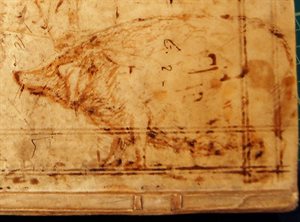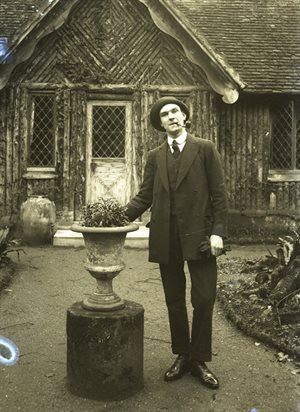Illustrations Collections
Illustrations is the term we use for anything that is a picture of something regardless of how the picture was produced therefore the term covers: drawings, paintings, engravings, lithographs, photographs. Although most archival material is written in words rather than pictures the archives service still holds millions of illustrations within its collections. Illustrations can be single items, such as one picture postcard in a collection of letters, a whole collection of different illustrations, such our Z50 collection of photographs, or a part of a larger mixed collection such as the photographs or advertising material in a business collection. Some illustrations are also part of a written document such as a drawing of a king or queen on a letters patent. Our illustrations are catalogued by provenance and are only brought together by our indexes.

BorBA1/22 - image of Queen Mary I
Bedfordshire Archives only started to acquire illustrations in significant numbers in the 1950s. Our first major acquisition was in 1953 when we received the comprehensive collection of important Bedford photographs and glass plate negatives bequeathed by George Gearey (1868-1952), reference X373. Gearey was a far-sighted enthusiast who collected old pictures and took his own photographs of Bedford streets and buildings threatened with demolition. It is a measure of the value of the collection in that it formed the basis for two informative picture books by Richard Wildman, Bygone Bedford (1974) and (with the Harry Wild collection, ref: Z224/22) Bedford: A Pictorial History (1991).
In contrast to the Gearey collection the extra illustrated Lyson’s Bedfordshire (ref: X254/88) deposited with the Casebourne papers in 1958 contains a wide-ranging variety of drawings, watercolours, engravings and photographs relating to many places across the county. For example, there is a drawing of Clifton bridge by R. Carter Smith after it had been swept away in the floods of 1823 (ref: X254/88/93) and a watercolour of the entrance to Totternhoe stone quarries painted by George Shepherd in 1813 (ref: X254/88/249).
In the early 1960s we began an active policy of copying many illustrations including family photographs, where deposit as a loan or as a gift was not a realistic option. The black and white copy photographs produced became part of the Z50 collection, which also includes photographs specially produced for the council. Since the council’s photographic unit closed in 1997 this series has been continued as digital files rather than hard copy prints. This series is mostly arranged by place with additional categories for individual and group portraits and miscellaneous subjects. The Z50 series is a good starting point if you are interested in finding images of locations but it should be noted that the provenance and copyright situation on many of the copy photographs is unclear.
We continued to collect original illustrations and important collections include the:
- Bedfordshire Press and Biggleswade Chronicle negatives c.1938-1969, acquired in 1969 (BP),
- Liz Munns photograph collection of Biggleswade, Potton and district deposited by Biggleswade History Society in 1989 (X758),
- George Arnald album purchased at auction in 1990 (Z693),
- Bedfordshire Press plastic negatives 1969-2000 (BP),
- Swain postcard collection gifted to us in 2003 (Z1130)
- Chrystal postcard collection purchased in 2007 (Z1306),
- Eric Meadows photographic collection gifted in 2009 (Z265)
- Tom Lawson collection of Leighton Buzzard received in 2011 (Z1432)
- Bruce Turvey photographic collection of Dunstable deposited in 2011 (BorD)
- Bedford Library prints collection transferred in 2016 (X1010)
- Rhind photographic collection of Luton and area received in 2018 (Z1691)
We are interested in pictorial material that provides evidence about the history of Bedfordshire or its inhabitants. Therefore our decisions as to whether to take an illustration into the collections does not depend on the artistic merit of the image but on the information that it provides. Clarity of the image, context and content are our main concerns.
The vast majority of our illustrations are either paper based, glass or plastic negatives or digital. Although we do have a handful of oil paintings this is a format that is usually more appropriate to an art gallery and therefore, if the subject of an oil painting is of interest to us, we will usually arrange to have photographic copies of the painting made for our collections rather than take in the painting itself. Under our collecting policy we reject duplicates and poor quality images such as fuzzy snapshots. Frames and glass are usually disposed of or returned for the sake of safe storage and retrieval.
As well as images that stand alone illustrations can be found in less obvious places, such as illustrated billheads and illustrations on maps or in documents. Even the doodles on a page or book cover can tell us something of the preoccupations of the doodler, such as the delightful drawing of a pig on the cover of the farm diary of John Gibbard of Sharnbrook, (X25/7).

X25/7 - farm diary of John Gibbard with illustration of a pig on the cover
Illustrations are often the only available evidence for changing scenery and buildings long since demolished. We are always interested in acquiring new pictures, unusual views of familiar stores, and in building up a series of similar views of various dates. Such views are valuable in noting changes in buildings over the years. A comparison of our pictures of The Porch and adjoining buildings in North Bridge Street, Shefford, in c.1919 (ref: Z1306/101/9/7) and again in 1954 (ref: Z50/101/33) shows replacement of some windows, removal of rendering, changes in the ownership of shops, and the introduction of signposts and “street furniture.”
Illustrations may tell us what our ancestors looked like, how they dressed and how they spent their time at work and leisure. Unfortunately many photographs of people arrive at the archives without any identification. Trying to identify and date such photographs can take a very long time, often with little final reward. The J H Copperwheat negative collection (X291/77) contains over 300 glass plates. They are a superb record of people in the Ampthill area in the early 20th century but most of them are unidentified forcing us to catalogue them as unknown man/woman/child/wedding group in garden/courtyard/field.

X291/77/24 - man outside the children's cottage and dairy at Wrest Park, Silsoe
Pictures often complement the information provided by documents. For example, one of our earliest photographs shows Toddington gamekeeper Norman Snoxell with a poacher in about 1854 (ref: P8/28/26/1). The diary of John Thomas Brooks of Flitwick (ref: LL17/283) tells us that the photographer, the Toddington antiquarian William Cooper-Cooper, received his photographic apparatus from London on 25 May 1853, while the Toddington burial register (ref: P8/1/16) informs us that Norman Snoxell was buried on 30 June 1855, aged seventy-three. Thanks to the background information supplied by the documents we are able to learn more about the picture and to date it fairly accurately.
Over the decades that we have been collecting illustrations we developed a number of indexes to suit different needs, unfortunately many of these are only available within our office. You can search the online catalogue but we admit there are some drawbacks to the way this works with illustrations. Ideally all items that are pictorial would be tagged as illustrations but sadly this is not the case – at best most illustrations will have been indexed by the type of illustration they are e.g. photographs, engravings, postcards. The best way to search for illustrations is to first search for the subject that you want to find a picture of, then, if that returns too many results to look through easily, search within the results for the type of illustration. In most cases you will not get to see what the image looks like. You will only get a written description of the image, which can sometimes be rather difficult to interpret, particularly if it is from a wider collection of images where the description given is only of the subject and does not state the type of image because the type of image is recorded higher up in the catalogue structure.
If you are looking for images of places from 1900-1920 then the best sources are our postcard collections (notably Z1130 and Z1306). These collections cover the whole of Bedfordshire and although many of the pictures used on them are of the more picturesque views of a town or village they may also include the less picturesque as well. The picture postcard flourished in the first twenty years of the 20th century. As well as providing a cheap and easy way to communicate they were easily collectable and many a card has a message indicating that the card had been sent as an addition to someone’s collection. The pictures on postcards could be printed in ink, usually either by a lithographic or half-tone process, or they could be a photograph.
If you require copies of illustrations we aim to be as helpful as possible but there are some factors outside our control. Whether we can supply copies will depend on what you wish to use the image for, the collection to which it belongs, and whether a copy can safely be made without damaging the original. The law of copyright is complicated and copyright lasts a lot longer than people often realise. A few owners of pictures (who may or may not also own the copyright) place restrictions on our supplying copies. We charge for the cost of making the copy. If the copy is to be published we also charge reproduction fees. You can find details of our current charges here on our website.